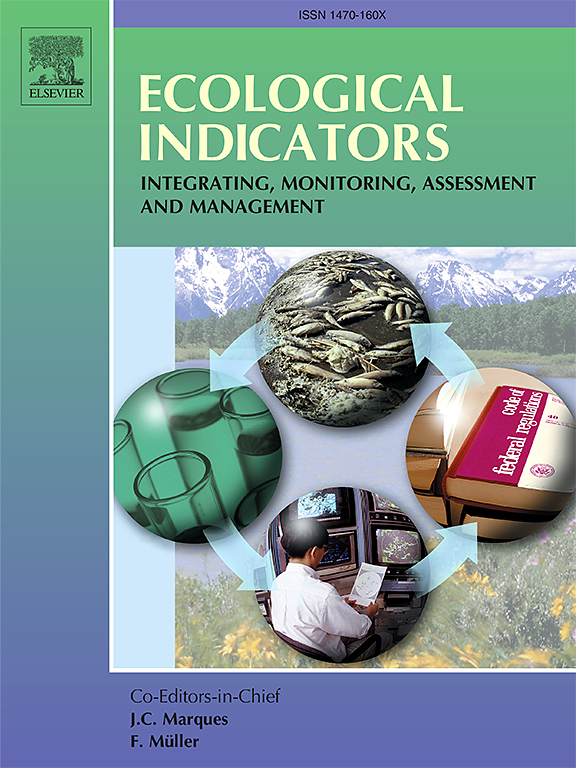昆虫传粉者越过美墨边境的国际边界障碍
IF 7
2区 环境科学与生态学
Q1 ENVIRONMENTAL SCIENCES
引用次数: 0
摘要
美墨边境沿线的基础设施可能不会对所有类型的昆虫传粉媒介都具有同样的渗透性,这可能会影响植物种群之间的花粉和基因流动。从2023年3月到2024年1月,研究人员观察了美墨边境两种类型的边界屏障(板条和胶结)的传粉媒介。在屏障附近,观察到昆虫的4种行为:1)飞越屏障,2)穿过屏障的板条,3)不穿过屏障,4)平行于屏障飞行而不穿过屏障。总的来说,90.2%的传粉者越过了屏障。蝴蝶最常飞越屏障(86.8%)或有时穿过屏障的板条(6.8%)。根据发生模型,在几个月的时间里,爬过板条的情况比飞越屏障的情况更常见。在有风的天气,蝴蝶和飞蛾有时会平行于屏障飞行而不穿越(分别为1.2%和27.3%),但飞蛾的穿越行为与丰度模型无关。温度越高,蝴蝶的丰度越高,风速越大,蝴蝶的丰度越低。其他传粉昆虫(蜜蜂、跳蝇、黄蜂)的杂交行为与模型关系不显著。因为传粉媒介支持濒临灭绝的植物物种,促进它们跨越屏障的策略可以支持南德克萨斯州的植物保护。本文章由计算机程序翻译,如有差异,请以英文原文为准。

Insect pollinator crossing of international border barriers along the U.S.-Mexico border
Infrastructure along the U.S.-Mexico Border may not be equally permeable to all types of insect pollinators with potential implications for pollen and gene flow between plant populations. Pollinators were observed on their approach to two types of border barriers (slatted and cemented) along the U.S.-Mexico Border from March 2023 to January 2024. Near the barrier, four insect behaviors were observed including 1) flying over the barrier, 2) crossing through the slats of the barrier, 3) not crossing the barrier, or 4) flying parallel to the barrier without crossing. Overall, 90.2% of the pollinators crossed the barrier. Butterflies were most often observed flying over the barrier (86.8%) or sometimes moving through the slats in the barrier (6.8%). It was more common for moths to crawl through the slats than to fly over the barrier based on the occurrence model. On windy days, both butterflies and moths sometimes flew parallel to the barrier without crossing (1.2% and 27.3%, respectively), although moth crossing behavior was not related to the abundance model. Butterfly abundance increased in higher temperatures and decreased in higher wind speeds. Other insect pollinators were also observed (bee, skipper, wasp) but their crossing behavior was not significantly related to the model. Because pollinators support endangered plant species, strategies to facilitate their barrier crossing could support plant conservation in South Texas.
求助全文
通过发布文献求助,成功后即可免费获取论文全文。
去求助
来源期刊

Ecological Indicators
环境科学-环境科学
CiteScore
11.80
自引率
8.70%
发文量
1163
审稿时长
78 days
期刊介绍:
The ultimate aim of Ecological Indicators is to integrate the monitoring and assessment of ecological and environmental indicators with management practices. The journal provides a forum for the discussion of the applied scientific development and review of traditional indicator approaches as well as for theoretical, modelling and quantitative applications such as index development. Research into the following areas will be published.
• All aspects of ecological and environmental indicators and indices.
• New indicators, and new approaches and methods for indicator development, testing and use.
• Development and modelling of indices, e.g. application of indicator suites across multiple scales and resources.
• Analysis and research of resource, system- and scale-specific indicators.
• Methods for integration of social and other valuation metrics for the production of scientifically rigorous and politically-relevant assessments using indicator-based monitoring and assessment programs.
• How research indicators can be transformed into direct application for management purposes.
• Broader assessment objectives and methods, e.g. biodiversity, biological integrity, and sustainability, through the use of indicators.
• Resource-specific indicators such as landscape, agroecosystems, forests, wetlands, etc.
 求助内容:
求助内容: 应助结果提醒方式:
应助结果提醒方式:


